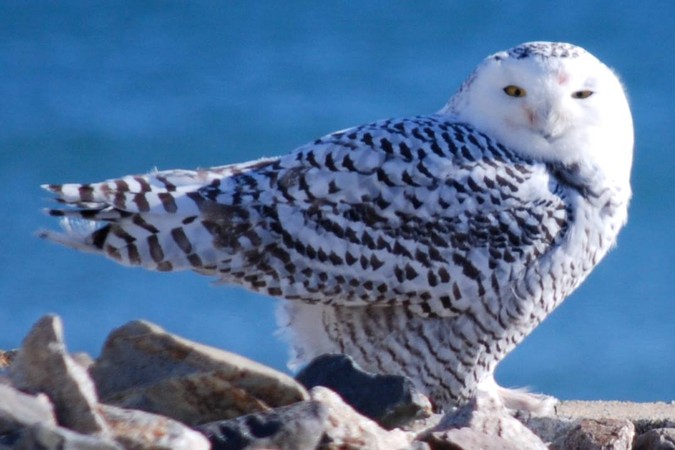The Wrack
The Wrack is the Wells Reserve blog, our collective logbook on the web.
The Wrack is the Wells Reserve blog, our collective logbook on the web.

Snowy Owl. You don't need to be a binocular-toting bird nut to bring this beast to the mind's eye. With the words come the impression: Big, white, stately, broad-faced, and with piercing yellow eyes. Awesome.
We're lucky in Maine. Snowies appear here just about annually. But this winter is something special.
The season's first report popped up on the maine-birds list on November 16. David Rankin had spotted one at "Snowy Central," better known as Biddeford Pool. Within days more reports flowed in, mostly from coastal areas, but including one that posed in front of the Mount A web cam for an afternoon. On the 22nd, Doug Hitchcox and Louis Bevier hinted at a potential big movement and just after Thanksgiving, Maine Audubon's Rare Bird Alert was dominated by snowy sightings.
That's when my search began. Though I've done my share of "bird chasing" over the years, I had long wanted to find my next Snowy Owl within the bounds of the Wells Reserve. It had been a long wait. With only a couple of near misses in well over a decade, I wondered if I had made a foolhardy commitment to myself. But with owls showing up "everywhere" this year, and in good number, I felt my luck might finally change.
Through the first half of December, I took brief detours on my way into work, driving down the Harbor Road or winding to Drakes Island to scan marsh, dune, beach, and jetty for big white lumps. I saw some nice birds — Snow Bunting and Purple Sandpiper come to mind — but I didn't catch my prize.
By this time, the northeast invasion had inspired Bruce Mactavish to report on the Newfoundland experience, Bob Duchesne to alert BDN readers, eBird authors to post Arctic Wanderers, and Kelley Bouchard to get the Press Herald onto the story.
On Friday the 13th, our own Paul Dest received a beautiful image taken near Wells Beach (this post's lead photo [1]) and shared it with the staff just as my year-end vacation began. 2013 drew to a close with no more harbor drive-bys, no more slips to the beach. My search would wait until January.
During the break, Nik Charov grabbed that amazing photo and uploaded it to Facebook. The shot garnered more than 1,500 Likes & Shares, inspired over 300 comments, and brought the Wells Reserve at Laudholm more than 200 new Facebook followers in less than a month (welcome to the fold, owl lovers). I kept seeing that face in my news feed, reading success stories on maine-birds, watching Michael Smith's nifty Maine snowies map get ever denser with dots, and growing impatient for the coast.
In January, I headed back to work and returned to my quick-stop birding routine. Then last Monday, while scanning the salt marsh south of Harbor Road, I eyed the unexpected. My bird was a quarter mile out, standing on the edge of a creek, crouch-walking to and fro, and gazing about. Then it flew to a new spot, got harassed by a crow, and pumped away… a 1-minute view to remember. (I believe it was my first snowy sighting since finding an arresting congregation of 16 on Washington's Damon Point in 1996, where every dune mound seemed to hold Nyctea scandiaca. [2])
The "why" of these snowy owl irruptions is linked to lemmings. Generally, it's assumed that owls flee the Arctic when prey populations crash (and no, these normal, cyclic lemming crashes aren't tied to mass suicide). But last summer was boom, not bust, for furry owl food, so this exodus apparently isn't driven by starvation. The host of scientists and owl aficionados launching Project SNOWstorm put it this way (with emphasis added):
The irruption appears to have been the result of a remarkably bountiful breeding season in northern Quebec, where the populations of lemmings and other rodents on which the owls feed were unusually high. All those lemmings translated into highly productive female owls, lots of eggs and many, many babies. Most of the irrupting snowies this winter are young owls. Conventional wisdom aside, most of them are plump and healthy, not driven south by starvation.
Of course, well fed babies during the summer-of-plenty may mean more competition for food after the snow flies, causing many youngsters to escape the crowd by heading south. Ahh, population dynamics — few simple answers.
Once the big birds get here, they aren't eating lemmings. They do catch other rodents, however, and they vary their diet with birds, too, as Chuck Homler's striking photo from Biddeford Pool attests.
So the irruption story continues to get told and people across the northeast and beyond enjoy perhaps their best chance ever to spot a real life Hedwig — respectfully, I hope. These charismatic creatures, even when obtaining enough food, still deserve some space. Pursuing them for that close-up look or perfect photo can stress a bird that normally spends life sitting still for hours. Our friend Kristen Lamb from the Center for Wildlife, which has admitted three of the birds already this winter, gave the right advice:
The best thing that people can do is appreciate them from a distance.